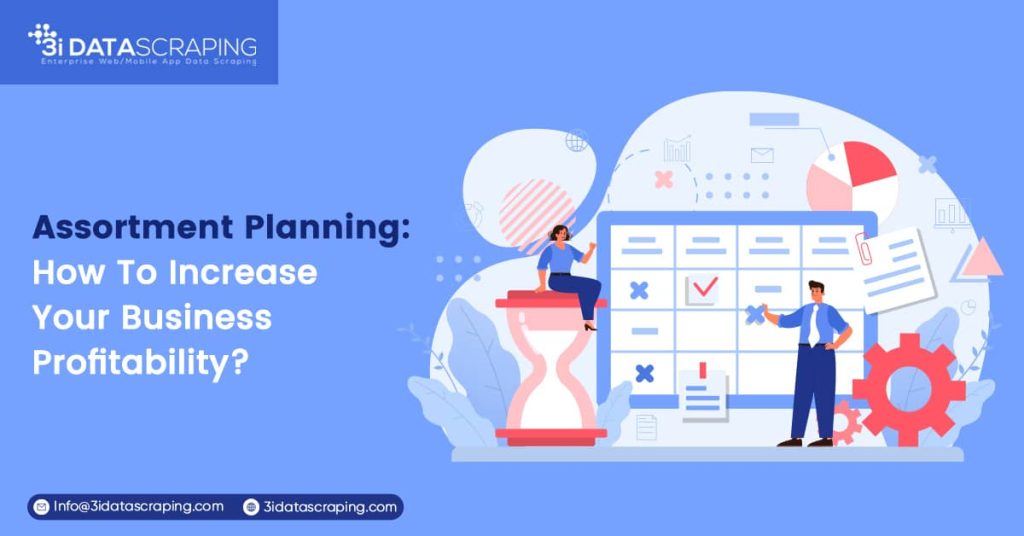Assortment Planning: How to Increase Your Retail Business Profitability?
In this blog post, you will learn about assortment planning and how to use it to improve your assortment planning and increase business profitability.
- May 17, 2023
Our achievements in the field of business digital transformation.









The primary objective of any business is to make money. The more you make, the better your business will be. But how do you know if your business is ringing in enough money?
This is where Assortment Planning in Retail comes in handy. It is one of the critical components of your business and can impact your profitability.
However, to do that, retailers must efficiently plan their assortment. The right assortment can increase sales and improve customer satisfaction, while an improper mix can lead to costly mistakes and lost customers.
In this blog, we will see why assortment planning in retail is essential for business profitability and ways to improve your assortment planning.
What Is Assortment Planning?

It is the process of creating and managing a Product Assortment in Retail. It is about the number, type, and variety of products you offer customers at anytime. It aims to ensure you are offering something for everyone.
Assortment planning can describe the process manufacturers or suppliers use to create an assortment for retailers or other buyers. Manufacturers can use this process to decide which products they should produce and how many of each model should be made to meet demand and balance supply with demand.
Why Is Assortment Planning Important?
Assortment planning in Retail aims to provide customers with various products and services to meet their needs. This is done by carefully considering what items will be offered for sale, how they will be priced when they will be available, and how they will be marketed.
It is essential because it helps companies manage inventory levels. By offering a wide range of products and services, companies can ensure they have something for everyone. This reduces the chance that customers will leave because they need help finding what they want.
When it comes to merchandise assortment, it is essential to know what customers want so that you can provide it in the right quantities at the correct times. You might gain sales if you offer enough variety because customers need help finding what they want on your shelves or catalogs.
If you offer less variety, you may end up with excess stock sitting on shelves or in warehouses that you can sell if only fewer options were available.
Product Assortment In Retail Planning Examples
The Product assortment strategies are the key to successful retailing. The following are some of the most important ones:
1. Wide Assortments
This type of product assortment in retail consists of only a limited number of items within a specific category. An example would be an electronics store with only one brand/model for each electronic device (such as television sets).
2. Deep Assortment
A deep assortment offers many products in a limited number of categories. For example, an apparel store might offer only pants and shirts but will have many different types of pants and shirts (e.g., jeans and khakis).
3. Scrambled Assortment
It is a product assortment strategy in which businesses consist of products of different categories or subcategories to provide consumers with an assortment that is more interesting and diverse. This can be an effective strategy for businesses looking to increase their sales, but it can also be risky if they don’t offer enough of each product to meet customer demand.
4. Localized Assortment
A localized assortment is a collection of products tailored to meet a local market’s needs. A company may have one or more localized assortments in each country. A localized assortment is a collection of products tailored to meet a local market’s needs.
The idea behind having localized assortments is to ensure each market has access to products that meet its unique needs and wants. This allows companies to serve the needs of their customers better and boost sales.
5. Mass-Market Assortment
This type of product assortment strategy focuses on offering a wide range of products to appeal to the most extensive possible customer base. A mass-market strategy is often associated with larger retailers with a wide range of product offerings and can afford to invest in more SKUs.
Top Tips for Assortment Planning for Business Success
Assortment Planning in Retail is critical for any retailer, but it can be challenging to get right. A poor assortment can even put your business at risk of failure. But if you follow these seven tips, you’ll have a better chance at success.
1. Set Realistic Goals
To meet a goal, you must first understand what it is. Goals should be specific and measurable. They must be stated in terms of what will be accomplished rather than how or when it will be accomplished.
The goal must be measurable to be evaluated and adjusted if necessary. For example, the goal is to reduce inventory by 10 percent by December 31st. You can measure by comparing inventory at the end of December with inventory on hand at the end of November.
2. Know your Customers
Before planning your assortment, you should understand your customers and their wants. This will help you determine what products to carry, which to focus on, and how much space each item should get in your store.
3. Make Sure You Have the Right Mix of Products
One of the essential steps in ensuring your assortment is effective is having the right mix of products. This means having enough variety so customers will not get bored with what’s available but not so much variety that people need to know where to start when looking for something specific. You want customers to be able to find what they need when they come into your store — if you do not have it, make sure you direct them from somewhere else.
4. Plan for Seasonality
Seasonality is one of the most important factors to consider when developing your assortment planning strategy. It is a trend with certain products and services, where sales volumes increase and decrease at specific times of the year.
For example, if you run a bakery, you can expect more customers to purchase your baked goods around the holidays and less during summer. If you sell any apparel or footwear, expect people to purchase more during warmer months and less during winter.
5. Create a Plan for New Products and Updates
Inventory planning is about what you have in stock and what you plan to get. This is a vital part of good assortment planning because it involves keeping track of what’s being released by manufacturers. That is why creating a plan for new products, seasonal products, and updates is essential. Product data scraping will make it easier for you to create a plan.
This may sound like an obvious step, but it is easy to remember these items when you are busy running campaigns and managing inventory levels. Planning for new products helps you ensure that there are always enough units in stock so customers can buy them.
6. Identify Your Seasonal Peaks and Low Points
Identify the times of year when your business typically experiences its most prominent peaks and troughs. If you sell summer clothes, these may be during winter. If you sell toys during the holidays, they might be slow during school breaks. Knowing when your inventory peaks or dips can help prevent any shortages or excess inventories from occurring at the wrong time of year.
Conclusion
So, you now understand the importance of having a good product assortment strategy for your business and the many benefits you can accrue from implementing it. Planning for assortment is something that fashion businesses should notice.
Though not all businesses will see an immediate increase in revenue or profits, there are enough benefits to this kind of planning to make it worthwhile. The key is developing long-term business strategies to adapt to your specific market over the years.














What Will We Do Next?
- Our representative will contact you within 24 hours.
- We will collect all the necessary requirements from you.
- The team of analysts and developers will prepare estimation.
- We keep confidentiality with all our clients by signing NDA.





